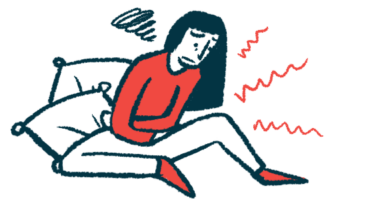Long-term Givlaari for AHP Found to Ease Pain, Lessen Attack Rate

Long-term treatment with Givlaari (givosiran) lessens rates of porphyria attacks, eases pain, and improves quality of life in individuals with acute hepatic porphyria (AHP), according to two-year interim data from the ENVISION trial.
Results were reported in the study, “Efficacy and safety of givosiran for acute hepatic porphyria: 24-month interim analysis of the randomized phase 3 ENVISION study,” published in the journal Liver International. The research was funded by Givlaari’s developer, Alnylam Pharmaceuticals.
AHP includes acute intermittent porphyria (AIP) and other forms of this group of genetic disorders, which are characterized by acute attacks. Like all porphyria types, AHP is caused by disruptions in the signaling cascade leading to the production of heme — a molecule needed for oxygen transport in living cells — which in turn results in the accumulation of toxic heme intermediates.
Givlaari is a widely approved AHP treatment that works by reducing the production of these toxic heme intermediates. It is administered via monthly subcutaneous (under-the-skin) injections.
Its approval for the treatment of AHP in the U.S. and Europe was supported by data from the Phase 3 ENVISION trial (NCT03338816), which enrolled 94 people with AHP (most commonly AIP) who were having regular porphyria attacks.
During the first six months of the trial, participants were randomly selected to receive either Givlaari (2.5 mg/kg) or a placebo. Data from this part of the study showed that those given the active treatment had significantly fewer attacks.
All but one participant who completed that first portion of the trial continued into its open-label extension phase, in which all participants were given Givlaari and monitored for safety and efficacy outcomes.
The new study reports detailed data from a pre-planned interim analysis, done once all active study participants had completed at least two years in ENVISION.
In line with earlier data, these results showed a substantial drop in the rate of porphyria attacks while participants were on long-term treatment with Givlaari. In study months 21 to 24 (the last three months analyzed), over three-quarters of participants were attack-free.
Consistently, Givlaari treatment also was associated with a substantial drop in the use of hemin, a therapy given to ease symptoms of recurrent porphyria attacks. In the open-label extension, most patients did not require hemin treatment. Indeed, the proportion of patients who did not need hemin exceeded 90% in the last months analyzed.
Over the course of the open-label extension, the average pain scores reported by participants decreased substantially. This was more pronounced in patients who had been on a placebo in the first six months of the study and only started taking Givlaari during the extension phase — referred to as the placebo crossover group.
Consistent with pain reduction, Givlaari treatment also was associated with a marked decrease in opioid use over the course of the extension study. In the placebo crossover group, the number of patients on opioids decreased from 83% to 67%, and the median number of days spent on opioids decreased from 8.5 to 5.7.
Additional analyses of patient-reported outcomes revealed improvements across a number of measures of general health and quality of life in all patients.
“Long-term treatment with [Givlaari] was associated with improvement in activities of daily living, perception of treatment, and living a more normal life, with improvements at 24 months seen in both the continuous givosiran and placebo crossover groups,” the researchers wrote.
However, Givlaari treatment was not associated with improvements in patient-reported fatigue or nausea.
Pharmacological analyses also indicated Givlaari substantially reduced the levels of two heme intermediates — delta-aminolevulinic acid (ALA) and porphobilinogen (PBG) — in the urine. In patients given the treatment for the full two years, these intermediate molecules were reduced to “near-normal levels,” while in those initially treated with a placebo, these levels dropped by more than 75% during the extension study.
Safety data in this interim analysis were largely “consistent with those observed during the 6-month double-blind period,” the researchers wrote. The most common adverse events (side effects) observed included injection-site reactions, nausea, fatigue, the common cold, and headache.
As of the analysis cut-off date (June 24, 2020), 10 patients had discontinued treatment, and seven had completely withdrawn from the study. The most common reasons for stopping treatment included adverse events, patient decision, and pregnancy.
“The 24-month data from this phase 3 study shows that long-term dosing with [Givlaari] is well tolerated and provides sustained and continuous benefit to patients with AHP, as reflected by a durable reduction in frequency of attacks, hemin use to treat attacks, levels of toxic heme intermediates ALA and PBG, daily pain, and opioid use,” the researchers wrote.
“[Givlaari] treatment was also associated with improvement in assessments of physical functioning” and quality of life, they added.







